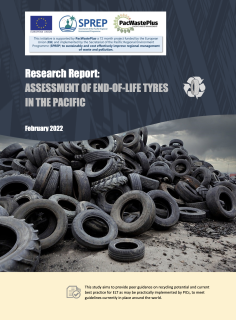
End-of-life tires (ELTs) are a source of either substitute materials or energy, replacing the need to that can replace virgin materials and fossil fuels and help conserve natural resources. The challenge and opportunity for all stakeholders is to create a system where ELT are considered as a resource available for useful and sustainable markets, without creating a financial burden for any single stakeholder.
Pacific region volumes of ELTs are approximately 7,000 tonnes per year (approximately 470,000 tires). However, existing ELT stockpiles throughout the region are unknown due to incomplete record keeping, but are estimated (from import/export data) to be around 125,000 tonnes (approximately 8.3 million tires).
This research provides the following recommendations for ELT recovery options for Pacific region countries:
-
Improvements in specific legislation are required in every Pacific country to identify ELTs as a separate waste stream requiring specific processing and disposal methods to reduce environmental and health risks.
-
Civil/infrastructure projects should use ELT in forms and at volumes appropriate for the application. Management of various stockpiles and allocation of ELT arisings by priority is required so that the ELT resource is optimized for all stakeholders. Public-private partnerships may be required to assist with infrastructure investment to set up the ELT processing assets.
-
Centralized collection and processing options should be investigated across jurisdictions if required, to consolidate stockpiles in volumes that make investing in ELT processing worthwhile. Likely locations for centralised processing based on geographic location, population and vehicle density are Fiji for Southern Pacific region countries and Papua New Guinea for Northern Pacific region countries. There are good reasons to review neighbouring countries (Australia, New Zealand, Malaysia) as alternative processing hubs, if shipping can be favourably priced using backfilling of containers, for example.
-
Utilization of ELT in future local cement clinker manufacturing operations should be investigated. If ELT could replace 7,000 tonnes of coal each year, then all the ELT produced in Pacific region country each year would be utilised.
-
A market analysis in each country should be undertaken to confirm the conclusions for each of the applications discussed in this report.
For more information, contact sprep [at] sprep.org.
